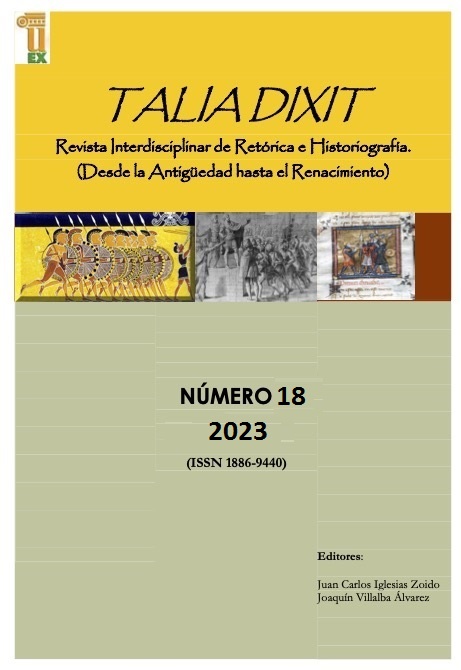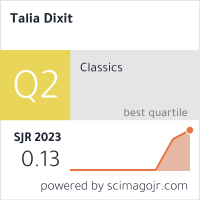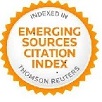The speeches in Appian's Mithridateios: A Preliminary approach
DOI:
https://doi.org/10.17398/1886-9440.18.1Palabras clave:
Apiano, Mithridateios, Mitrídates, Sila, Pompeyo TrogoResumen
Appian’s Mithridatheios contains a considerable number of formal speeches, to which others found by the author in his sources could have been added, but he chose not to develop them. Most of these passages relate to the First Mithridatic War, in line with the prominence that Appian attributes to Sulla in the crisis of the Roman Republic. While the Roman general delivers the longest speeches in this work, Mithridates has only three, which also appear notably abbreviated. Very possibly, Pompeius Trogus’ historical work was the source for the main rhetorical passages.
Descargas
Referencias
Adler, E. (2011), Valorizing the Barbarians. Enemy Speeches in Roman Historiography, Austin: University of Texas Press.
Ballesteros Pastor, L. (1996), Mitrídates Eupátor, rey del Ponto, Granada: Servicio de publicaciones de la Universidad de Granada.
Ballesteros Pastor, L. (1999), “Dos Apuntes Sobre Manio Aquilio (cos. 101 a. C.)”, Habis 30: 135-141.
Ballesteros Pastor, L. (2013a), “Nullis umquam nisi domesticis regibus. Cappadocia, Pontus and the Resistance to the Diadochi in Asia Minor”, in Alonso Troncoso, V. & Anson, E.M. (eds.), After Alexander: The Time of the Successors (323-281 BC), Oxford: Oxbow, pp. 183-198.
Ballesteros Pastor, L. (2013b), Pompeyo Trogo, Justino y Mitrídates. Comentario al Epítome de las Historias Filípicas (37,1,6-38,8,1), Hildesheim, Zürich & New York: Georg Olms Verlag.
Ballesteros Pastor, L. (2016), “Mitrídates Eupátor, un enemigo de Roma en el Epítome de Justino”, in Galimberti, A. & Zecchini, G. (a cura di), Studi sull’Epitome di Giustino. Vol. 3. Il Tardo Ellenismo. I Parti e i Romani, Milano: Vita e Pensiero, pp. 63-97.
Ballesteros Pastor, L. (2017), “Justin’s corpusculum florum. The Selection and Manipulation of Trogus’ Historiae Philippicae”, in Iglesias Zoido, J.C. & Pineda, V. (eds.), Anthologies of Historiographical Speeches from Antiquity to Early Modern Times. Rearranging the Tesserae, Leiden & Boston: E.J. Brill, pp. 79-94.
Ballesteros Pastor, L. (2023), “Pontus and Sophene in the Late Hellenistic Period: the King Arsaces and the Prince Arcathias”, Zeitschrift für Papyrologie und Epigraphik 226: 104-112.
Bean, G.E. (1948), “Notes and Inscriptions from Lycia”, Journal of Hellenic Studies 68: 40-58.
Brock, R. (1995), “Versions, ‘Inversions’ and Evasions: Classical Historiography and the ‘Published’ Speech”, Papers of the Leeds International Latin Seminar 8: 209–24.
Bucher, G.S. (2000), “The Origin, Program, and Composition of Appian's Roman History”, Transactions of the American Philological Association 118: 411-458.
Calabi, I. (1950), “I commentarii di Silla come fonte storica”, Memorie dell’Accademia Nazionale dei Lincei, s. 8ª 3, 5: 427-302.
Carmona Centeno, D. (2005), “Variatio en el discurso exhortativo: la batalla de Zama”, Anuario de Estudios Filológicos 28: 5-19.
Carmona Centeno, D. (2009), “Historiografía, retórica y ejemplaridad: la escena típica del estandarte y su función en las historias de Roma”, in Iglesias Zoido, J.C. (ed.), Retórica e Historiografía. El discurso militar en la Historiografía desde la Antigüedad hasta el Renacimiento, Madrid: Ediciones Clásicas, pp. 273-295.
Carmona, D. (2014), La escena típica de la epipólesis, de la épica a la historiografía, Roma: Edizioni Quasar.
Carsana, C. (2013), “Discours vrais ou inventés? Le cas d’Appien”, Dialogues d’Histoire Ancienne 39 : 103-123.
Cowan, E. (2015), “Deceit in Appian”, in Welch, K. (ed.) (2015: 185-203).
Cuff, P. J. (1983), “Appian’s Romaica: a Note”, Athenaeum 61: 148-164.
Desideri, P. (1973), “Posidonio e la Guerra Mitridatica”, Athenaeum 61: 3-29, 237-269.
Dueck, D. (2006), “Memnon of Herakleia on Rome and the Romans”, in Bekker-Nielsen, T. (ed.), Rome and the Black Sea Region: Domination, Romanisation, Resistence, Aarhus: Aarhus University Press, pp. 43-61.
Famerie, É. (1998), Le latin et le grec d’Appien. Contribution à l’étude du lexique d’un historien grec de Rome, Genève: Droz.
Gabba, E. (1957), “Sul Libro Siriaco di Appiano”, Memorie dell’Accademia Nazionale dei Lincei. ser. 8, 12: 339-351.
Gabba, E. (1958), Appiano e la storia delle guerre civili, Firenze: La Nuova Italia.
Gabba, E. (1971), “Appiano traduttore in B.C. V 191”, in Studi di storiografia antica. In memoria di Leonardo Ferrero, Torino: Bottega d’Erasmo, pp. 185-189.
Goldmann, B. (1988), Einheitlichkeit und Eigenständigkeit der Historia Romana des Appian, Hildesheim, Zürich & New York: Olms.
Goukowsky, P. (2001), Appien. Histoire Romaine. Livre XII. La Guerre de Mithridate, Paris: Les Belles Lettres.
Goukowsky, P. (2008), “Introduction générale”, in Id. & Hinard, F., Appien. Histoire Romaine. Livre XIII. Guerres Civiles. Livre I, Paris: Les Belles Lettres, pp. vii-lxxxviii.
Hahn, I. (1982), “Appian und seine Quellen”, in Wirth, G. (ed.), Romanitas-Christianitas. Untersuchungen zur Geschichte und Literatur der römischen Kaiserzeit: Berlin & New York: De Gruyter, pp. 251-281.
Hopwood, B. (2015), “Hortensia speaks. An authentic Voice of Resistance?”, in Welch, K. (ed.), (2015: 305-322).
Iglesias Zoido, J.C. (2007), “The Battle Exhortation in Ancient Rhetoric”, Rhetorica 25: 141-158.
Iglesias Zoido, J.C. (2011), El legado de Tucídides en la cultura occidental, Coimbra: Coimbra University Press.
Leydold, M. (2020) “Wann eroberte Mithridates die Provinz Asia?”, Klio 102: 579-600.
Loraux, N. (1981), L’invention d’Athènes. Histoire de l’oraison funèbre dans la “cité classique”, Paris: Éditions de l’EHESS.
Luce, T.J. (1961), “Appian’s Magisterial Terminology”, Classical Philology 56: 21-28.
Mastrocinque, A. (1999), Studi sulle Guerre Mitridatiche, Stuttgart: Franz Steiner.
Marco, E. (2023), “Appiano, lettore di Plutarco? La synkrisis tra Alessandro e Cesare (Bella Civilia 2.149-154)”, in Id. & Fontana, A. (a cura di), Ceci n’est pas un compilateur. Qualche riflessione su autori greci di età imperiale, Genoa: Genova University Press, pp. 53-68.
McGing, B.C. (1980), “Appian, Manius Aquillius, and Phrygia”, Greek, Roman and Byzantine Studies 21: 35-42.
McGing, B.C. (1986), The Foreign Policy of Mithridates VI Eupator, King of Pontus, Leiden: Brill.
McGing, B.C. (1993), “Appian’s Mithridateios”, Aufstieg und Niedergang der römischen Welt II, 34.1, Berlin: De Gruyter, pp. 496-522.
McGing, B.C. (2003), “Review of P. Goukowsky, Appien. Histoire Romaine. Livre XII. La Guerre de Mithridate”, Classical Review 53: 319-321.
McGing, B.C. (2019), Appian. Roman History. Volume I, (Loeb Classical Library Second Edition), Cambridge Mass. & London: Harvard University Press.
McGing, B.C. (2021), “The Beginning and End of Appian’s Mithridateios”, Classical Quarterly 71: 791-798.
Osgood, J. (2015), “Breviarium totius imperii: the background of Appian’s Roman History”, in Welch, K. (ed.) (2015: 23-43).
Pitcher, L.V. (2023), “Tucydides in Greek and Roman Historiography”, in Low, P.A. (ed.), The Cambridge Companion to Thucydides, Cambridge: Cambridge University Press, pp. 233-248.
Reinach, T. (1890), Mithridate Eupator, roi de Pont, Paris: Firmin-Didot.
Rich, J. (2015), “Appian, Polybius and the Romans’ war with Antiochus the Great: A study in Appian’s sources and methods”, in Welch, K. (ed.) (2015: 65-123).
Rich, J. (2020), “Appian, Cassius Dio, and Seneca the Elder. New Perspectives on Early-Imperial Roman Historiography”, in Scappaticcio, M.T. (ed.), Seneca the Elder and his Rediscovered Historiae ab initio bellorum civilium, Berlin & Boston: De Gruyter, pp. 329-353.
Rizzo, F.P. (1963), Le fonti per la storia della conquista pompeiana della Siria, Palermo: Banco di Sicilia.
Salomone Gaggero, E. (1979), “La lotta antiromana di Mitridate. Divergenze cronologiche nelle fonti”, Sandalion 2 : 129-141.
Sancho Royo, A. (1980), Apiano. Historia Romana, Tomo I, Madrid: Gredos.
Santamato, E. (2013), “Il discorso di Bruto (BC 2.19.138-140) e l’introduzione ai Bella Civilia (BC 1.1.7-8) in Appiano: studio sulla communicazione appianea”, Göttinger Forum für Altertumswissenschaft 16: 237-277.
Santangelo, F. (2007), Sulla, the Elites and Empire. A Study of Roman Policies in Italy and the Greek East, Leiden: Brill.
Santangelo, F. (2009), “With or without you: some Late-Hellenistic Narratives of Contemporary History”, Scripta Classica Israelica 28: 57-78.
Schropp, J.W.G.; Manning, S. (2019), ‘‘‘Too Many for an Embassy, too Few for an Army’. On the Origin and Scope of a Tigranic dictum”, Zeitschrift für Papyrologie und Epigraphik 212: 83-88.
Smith, D.L. (2012), The Rhetoric of Interruption: Speech-Making, Turn-Taking, and Rule-Breaking in Luke-Acts and Ancient Greek Narrative, Berlin & Boston: De Gruyter.
Steel, C. (2019), “Sulla the Orator”, in Eckert, A. & Thein, A. (eds.), Sulla, Politics and Reception, Berlin & New York: De Gruyter, pp. 19-32.
Thein, A. (2014), “Reflecting on Sulla’s Clemency”, Historia 63: 166-186.
Torres Guerra, J.B. (2006), “Apiano de Alejandría, traductor (BC IV 45 y V 191)”, Emerita 74: 17-28.
Van Wickevoort Crommelin, B.R. (1990), Die Universalgeschichte des Pompeius Trogus. Herculea audacia Orbem Terrarum adgressus, Hagen: Magrit Rottmann.
Veh, O. & Brodersen, K. (1987), Appian von Alexandria. Römische Geschichte, erster Teil: die römische Reichsbildung, Stuttgart: Anton Hiersemann.
Welch, K. (ed), Appian’s Roman History: Empire and Civil War. Roman culture in an age of civil war, Swansea: Classical Press of Wales.
Wesch-Klein, G. (2001), “Bithynia, Pontus et Bithynia, Bithynia et Pontus - ein Provinzname im Wandel der Zeit”, Zeitschrift für Papyrologie und Epigraphik 136: 251-256.
Westall, R. (2015), “The sources for the Civil Wars of Appian of Alexandria”, in Welch, K. (ed) (2015: 125-167).














